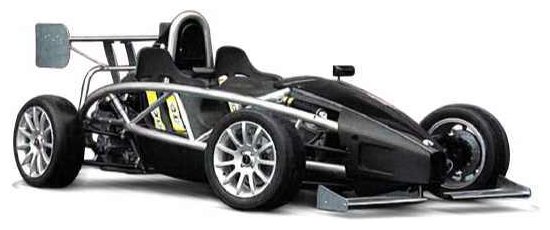The dawn of the new millennium brought us many automotive innovations, but few were as radical as the Ariel Atom 2. In an era when supercars were getting heavier and more complex, this British track weapon chose a different path — one of absolute minimalism and pure driving focus.
The automotive world of 2004 witnessed something extraordinary: a road-legal race car that challenged every conventional notion of what a performance vehicle should be. The Atom 2 wasn’t just another sports car; it represented a fundamental rethinking of the relationship between power, weight, and driver engagement.
Engineering Brilliance in Its Purest Form
The heart of the Atom 2 beats with Honda’s legendary K20A engine — a 2.0-liter masterpiece delivering 220 horsepower in its naturally aspirated form. But raw power tells only part of the story. The real magic lies in how this output translates through a chassis weighing merely 570 kilograms.
Ariel’s engineers achieved this featherweight status through a revolutionary tubular frame design. Every element serves a purpose; there’s nothing superfluous, nothing unnecessary. The result is a power-to-weight ratio that rivals supercars costing many times more.
“The Atom 2 represents the pinnacle of power-to-weight optimization. It’s possibly the closest thing to a formula car that’s street legal,” remarks James Mitchell, former racing engineer at Lotus.
The six-speed manual transmission, sourced from Honda, provides rifle-bolt precision. Each gear change feels mechanical and purposeful, connecting driver and machine in a way modern electronics never could.
Fact!
The Atom 2's frame consists of over 150 precision-welded steel tubes, each positioned to maximize structural rigidity while minimizing weight. This architecture was inspired by motorcycle frame design principles.
Track-Ready Performance That Defines Excellence
Raw numbers only hint at the Atom 2’s capabilities. The sprint to 60 mph takes just 4.4 seconds, but the sensation of acceleration feels even more dramatic. With no bodywork to separate you from the elements, every increment of speed becomes a visceral experience.
The handling characteristics redefine what’s possible in a road-legal vehicle. The fully adjustable suspension, developed in collaboration with Lotus, provides unprecedented feedback and control. The car responds to inputs with an immediacy that makes conventional sports cars feel sluggish in comparison.
“I’ve driven everything from F1 cars to modern hypercars, but nothing connects you to the road quite like the Atom 2,” says Michael Turner, professional racing instructor.
Important!
The Atom 2's steering rack has just 1.8 turns lock-to-lock, making it one of the quickest-steering road cars ever produced. This setup demands respect and skill but rewards with unprecedented precision.
Design Philosophy: Function Defines Form
The Atom 2’s appearance stems from pure functionality. The exposed frame isn’t a styling choice; it’s an engineering solution that optimizes weight distribution and aerodynamics. Key features worth noting:
- integrated roll cage providing both safety and structural rigidity;
- adjustable front and rear wings for optimized downforce;
- exposed suspension components allowing quick trackside adjustments;
- transparent aerodynamic side panels reducing turbulence.
Each component’s placement follows a ruthless efficiency logic. The result is a machine that looks like nothing else on the road, simply because it’s designed purely for performance.
Legacy and Market Impact
The Atom 2’s influence extends far beyond its limited production numbers. It demonstrated that ultimate performance doesn’t require complexity, inspiring a generation of track-focused vehicles. Today, mint examples command premium prices at specialist auctions, reflecting their significance in automotive history.
The car’s impact on track day culture cannot be overstated. It showed that a road-legal vehicle could deliver genuine race car performance without compromise. This philosophy continues to influence modern special editions from major manufacturers.
The Future Through the Prism of the Past
Two decades later, the Atom 2’s approach to performance feels more relevant than ever. As mainstream vehicles grow increasingly complex, its pure, driver-focused philosophy provides a compelling counterpoint. It reminds us that the essence of driving pleasure lies not in technology, but in the direct connection between human and machine.
The Atom 2 stands as proof that sometimes, the boldest step forward is a return to fundamentals. In stripping away everything non-essential, Ariel created something timeless.
Pros & Cons
| Advantages | Disadvantages |
|---|---|
| Exceptional power-to-weight ratio delivering supercar performance | Limited weather protection makes it challenging for daily use |
| Unmatched driving engagement and feedback | Minimal storage space restricts practicality |
| Outstanding track day capabilities | Loud cabin environment can be fatiguing on longer drives |
| Highly adjustable suspension for precise setup | Limited availability and high maintenance costs |
| Excellent build quality and engineering | Not suitable for all weather conditions |
| Strong collector value and appreciation potential | Requires significant driving skill to exploit full potential |
The Ariel Atom 2 represents a singular vision of automotive excellence, prioritizing pure driving experience over practicality. While it may not suit everyone’s needs, for the dedicated enthusiast seeking the ultimate in driver engagement, few vehicles come close to matching its capabilities. Its influence on track-focused vehicle design continues to resonate, cementing its place in automotive history as more than just a car — it’s a benchmark for what’s possible when engineers pursue performance without compromise.

